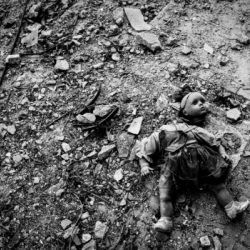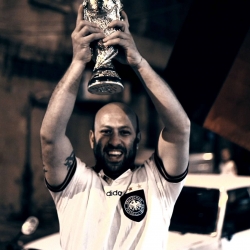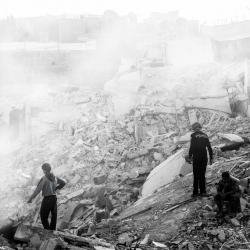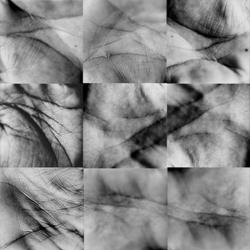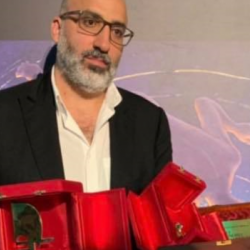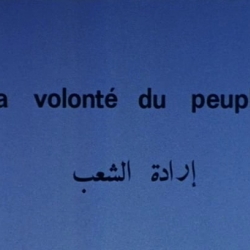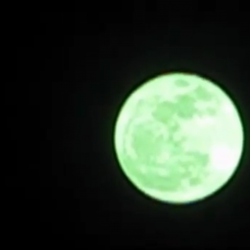04/12/2017
Author: Nicolas Appelt
The voice messages as well as the Skype conversations with the parents and sister of the director of On the Edge of Life (Yaser Kassab, 2017) mingle with void: that of the static landscapes of the Turkish countryside and that of the road when leaving Beirut. Then appears a figure of the absence. It corresponds as much to that of the relatives – namely the brother who disappeared, killed by a bomb that fell on Aleppo – as to that of the country. The hypnotic landscapes refer to the impossibility of seeing and understanding the real-life experience of those who stayed in Syria. “You haven’t seen anything”. It is also what underpins the exchanges between Soudade Kaadan, the director of Obscure (2017) and Ahmad, the young man who stubbornly refuses to remember where he comes from. In a haunting way, the three questions – Where do you come from? Are you sleeping? Can you forget?- that the director asks the child, punctuate the film., The three questions are sustained by John Cale’s music and install a repetition that stresses the impression of confinement and gravity that is present in the film. Just like in the case of X, the character of the Last Year at Marienbad (Alain Resnais, 1961) where repetition occupies an essential place, the director tries to restore a buried memory. “You haven’t seen anything”, finally, this is what Houses without Doors (2016) by Avo Kaprealian questions in full. While facing internally displaced persons, who have found temporary shelter opposite the family apartment –namely a young man-, the director faces equally the impossibility of seeing and understanding what the child he is filming has endured.
“You haven’t seen anything” could be considered as a factual temporal consequence of the reduction of the space for demonstration, protest and creation, which has settled /occurred ? in the country because of the militarization of the Syrian crisis. Due to the shrinking of this space, of which image taking could be part, a frontier would settle. Many directors whose movies have been shot in or from an apartment would collide to this frontier. Besides Houses without Doors, that was filmed partly from the balcony of the apartment in Aleppo, Haunted (Liwaa Yazji, 2014) or even Coma (Sara Fattahi, 2015) illustrate this withdrawal to the private sphere. The apartment thus becomes a metaphor for this part of the Syrian society which is forced to contend with awaiting and uncertainty. In another context, the artistic creation space, allowing an amateur group to gather, which is filmed by Rafat Alzakout in Home (2015) becomes a place that is more and more defined by the threats that come from the outside. Finally the documentary 194, Us Children of the Camp (Samer Salameh, 2017) shows also how the Palestinian camp of Yarmuk, - actually a neighborhood of Damascus -, becomes gradually no longer a place of challenge, but a safety net from which it becomes dangerous to move out, sometimes even at the cost of one’s life.
« I have seen it all »
However, establishing a correlation between the shrinking of the space of protest and creation[1], which would constitute an insurmountable barrier, and a decrease of possibilities of directing movies, would indeed be a total fallacy. In fact, in the face of the constraints imposed by the evolution of the political military situation, many directors have developed formal means for attempting to understand rightfully the evolution of the Syrian crisis. Even if they differ with respect to the process that enables them to understand this evolution, it is worth noting a common feature. All these films are narrated by the person concerned and the directors get involved in all cases[2]. These documentaries either establish a dialogue with the persons who are filmed -as in 300 miles (Oroa al-Mokdad, 2016) or Houses without Doors-, or they make them appear directly in front of the camera -e.g. On the edge of life, Coma, Haunted or Home. In 300 miles, for example, in one of the first scenes of dialogue between the director and the Chief of the brigade, Abu Yabrud, the latter looks at the camera while addressing his interlocutor. There is a slight lag that shows that the camera is not carried by Oroa al-Mokdad, but he is sitting facing Abu Yabrud, in the axis of his eyes. Consequently, the spectator is put in a position slightly outside this dialogue. This process / setting? stresses the impression of the director’s involvement by pushing him to relinquish his camera-holding role and by placing him in the role of interlocutor, stakeholder of the situation.
Yassin Al Haj Saleh, equally actor, political opponent and analyst of the Syrian uprising in 2011, explains that, unlike the massacre of Hama in 1982, the “Syrian revolution […] documents itself day by day” and “it is seeking to find the way of a public narrative”[3]. Many documentaries participate in a process of « public narrative » evoked by Yassin Al Haj Saleh. They do so through a recuperation of memory, including the most immediate events. Their perspective resonates with Milan Kundera’s novel The Book of Laughter and Forgetting and more specifically the part in which Tamina finds herself prisoner on an island inhabited by children belonging to a movement of pioneers called the Squirrels. Tamina is faced with a world that glorifies youth by banishing the memory. Her struggle to survive by fleeing the island somehow mixes with her will to struggle against oblivion. Likewise, some documentaries express « I have seen it all » through a struggle for regaining a memory, or rather memories: family memories that mix with those of Syria or the region. They thus cross a first border that is imposed on them. The approach adopted by Oroa al-Mokdad in 300 miles wonders about the situation prevailing in Syria by repeating the family narrative, when, like his grandfather during the 1948 war that led to the creation of the State of Israel, as well as his mother and his niece, Nour – to whom he addresses his narrative – fled Iraq after the American invasion in 2003. In 194, Us Children of the Camp, Samer Salameh questions the running of the Syrian crisis through the prism of the Palestinian memory as well as its manipulation by the regime. Moreover, his documentary reveals an entanglement of the memories, since the personal memories – the ones of his family and the ones of his friends – become guiding threads of the narrative too by mixing with the ones of the Syrian crisis. The materialization of the question of these memories takes the shape of a film reel, which he unrolls frenetically before leaving the Yarmouk camp. The roll covers the ground like some kind of golden thread that could get him out of the memory meanders . Finally, in the case of Avo Kaprealian, the recapturing of the memory of the events that are lived by his young neighbor is translated in the use of sequences of the surrealistic and even metaphysical western movie of Alejandro Jodorowsky, El Topo (1970), that are inserted into Houses without Doors. The images of bloody killing that are extracted from the western movie are the only means for Avo Kaprealian to represent what the young man has been through. They are used to underline the innocence that he lost definitively when, in the scene of Alejandro Jodorowsky’s movie, the boy finds himself with a gun in the hand and obliged to end the life of a dying person. This blind and brutal violence echoes the one practiced by the regime, where the issue of who is being killed is no longer important. This question comes also within the family memory of the director whose ancestors took refuge in Aleppo, in order to escape the massacre perpetrated against the Armenians. The monologue detailing the atrocities faced by the Armenians and drawn from the Mayrig movie (Henri Verneuil, 1991) that Avro Kapealian superposes to the images of the bystanders, a group of old men on the sidewalk in the bottom of his building, or even that of the young boy, may be perceived as an attempt to understand the vécu / lived experice? of other Syrians on the basis of a family memory that comes within a tragedy not much documented for the time being. Even if Hiroshima mon amour (Alain Resnais, 1959) belongs to the universe of fiction, a parallel may be drawn with the process of the character played by Emmanuelle Riva. Based on her memories and traumas, she tries to get close to the ones of her lover and the tragedy lived by the inhabitants of the city. “I have seen it all”.
The Resnais film tells us about another crossing of borders that is found in many Syrian documentaries: the re-appropriating of the space that opposes the confinement imposed on it by the escalation of violence. In fact, the hand that is moved by “Her” (Elle) on the back of “Him” (Lui) resembles at the end, in some form of “visual echo”, to the “branches of the estuary of the delta” of the city of Hiroshima[4]. So the re-appropriation of the space by one part of the body is highlighted by the image frame. In many Syrian documentaries, this re-appropriation of the space involves the use of long plans fixed on details, rituals of the daily life, such as smoking a cigarette, drinking coffee or tea after having prepared it on a gas cooker, or the TV sets (Haunted, Coma, Home, 300 miles, 194, Us Children of the Camp). In 194, Us Children of the Camp, Samer Salameh films along with the film dedicated to the memory of his family, the stages of the edification of the wall of a building facing his apartment. This gesture underlines the will to continue to occupy a space in spite of all the difficulties. As for the short movie Frontline (Saeed al-Batal, 2014), the re-appropriation of the space involves the “recuperation” of one of the symbols of the regime epoch, the songs of Fayrouz, the emblematic Lebanese artist, that are played with no exception every morning on the Syrian official radio station and are listened to by the sniper of the Free Syrian Army on a small transistor. Albeit being designated by the regime authorities as a « terrorist » at the margin of society due to his engagement, this man carries with him a memory. This memory is a mark of his past life, the one of the person who used to take the bus every morning or used to get notified of the arrival of the truck selling gas bottles in the town of Tartus. Saeed al-Batal in one of the last scenes films this man in close-up chest image, in such a way that he occupies an important part of the camera frame, while he defends his space by listening to Fayrouz. In Houses without Doors, the crossing of borders takes place through the editing by diversion of images of Bachar al-Assad crossing victoriously the huge doors of a palace and walking on a red carpet in front of the guards showing their arms. It also takes place by the insertion of images of insurgency like that of Prague in 1968. The place used for one of the stagings of the power shows its megalomania and its excessiveness while the archive images reposition the Syrian uprising in a global context, rendering more common the aspirations held by one part of the Syrian population. Finally, in 300 miles the crossing of frontiers is concretized in 300 miles by the movement made by Oroa al-Mokdad throughout Syria, from Aleppo to Deraa, through smugglers. It is also accomplished by video recordings that his niece Nour makes for him in Deraa where she lives with a part of her family, after having left Damascus. The film is built in part on a mirror game - sometimes inverted - a game that reinforces the feeling of crossing internal borders being erected throughout the country. The director questions Abu Yabrud in Aleppo., But it is also him who is questioned by his niece, in a direct way when she addresses the camera, or in an indirect way when she interrogates one of Oroa al-Mokdad’s brothers. We see nothing of the intimate or family life of Abu Yabrud, while we see only Nour’s father leaving the family domicile to join his men. We see this reflection in negative format right into the colors of the documentary, much darker in Aleppo than in Deraa.
The aforementioned documentaries, although in different forms, present more similarities than those already revealed through this approach led by the use of the “I” subject, in an attempt to understand what is happening in Syria. These films evoke, in fact, Georges Perec’s process in W, or the Memory of Childhood. Starting -for some of them at least- from elements of personal memory, they aim at allowing, not the creation of an imaginary place, although reminding the repression camps mentioned by David Rousset who is quoted in the text, but rather the elaboration of a perception of the tragedy that is witnessed by Syria, this country which they are deprived of seeing, and which they are deprived of realizing. Yet, “I have seen it all”.
[1] Robin Yassin-Kassab, Leila Al-Shami, Burning Country. Syrians in Revolution and War, London, Pluto Press, 2016, p. 177
[2] Ziad Adwan, « The Anxious Ego. Syrian Documentaries in the Syrian War », Syrious Look, November 2016
[3] Ibid., p. 237
[4] Luc Lagier, Hiroshima mon amour, Paris, Editions Cahiers du Cinéma, 2007, p. 85








